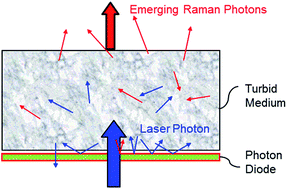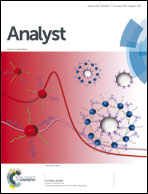Development of Transmission Raman Spectroscopy towards the in line, high throughput and non-destructive quantitative analysis of pharmaceutical solid oral dose†
Abstract
Transmission Raman spectroscopy (TRS) is a recently introduced analytical technique to pharmaceutical analysis permitting volumetric sampling by non-destructive means. Here we demonstrate experimentally, for the first time, the enhanced speed of quantification of pharmaceutical tablets by an order of magnitude compared with conventional TRS. This is achieved using an enhancing element, “photon diode”, avoiding the loss of laser photons at laser coupling interface. The proof-of-concept experiments were performed on a complex mixture consisting of 5 components (3 APIs and 2 excipients) with nominal concentrations ranging between 0.4 and 89%. Acquisition times as short as 0.01 s were reached with satisfactory quantification accuracy for all the sample components. Results suggest that even faster sampling speeds would be achievable for components with stronger Raman scattering cross sections or with higher laser powers. This major improvement in speed of volumetric analysis enables high throughput deployment of TRS for in line quality control applications within the batch or continuous manufacturing process and facilitating non-destructive analysis of large fractions.

- This article is part of the themed collection: Analytical Sciences in the UK

 Please wait while we load your content...
Please wait while we load your content...